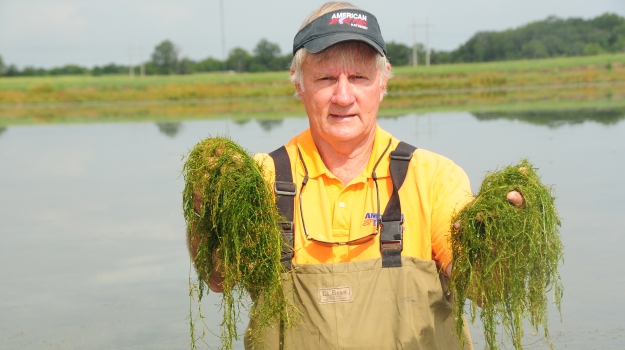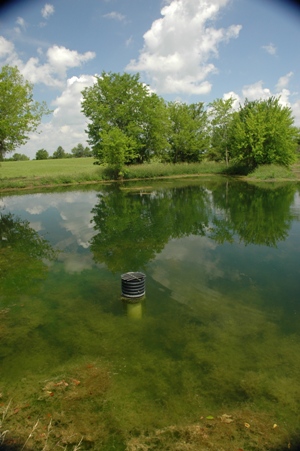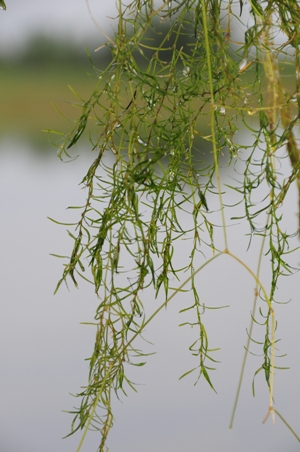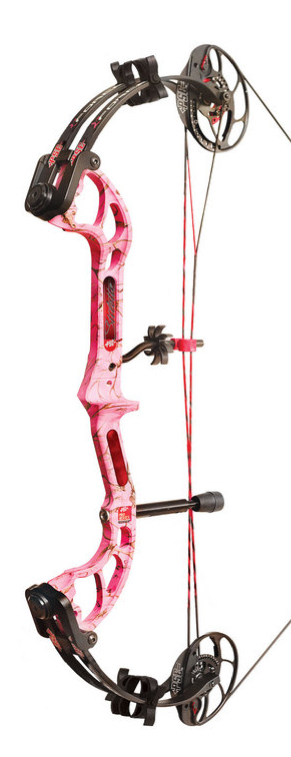
By Don C. Keller
In the South, after the cold days of winter have passed, warmer temperatures and more sunshine are usually welcomed enthusiastically.
For some lake owners, however, warmer temperatures and more sunshine may also stimulate undesirable plant growth. Unfortunately, many landowners who go to their ponds in spring and early summer to begin their fertilization program find submerged vegetation growing in the clear, shallow water.
 One of the more common submerged plants is southern naiad (Najas guadalupensis.) Southern naiad is a rooted native aquatic plant that grows from the bottom of the pond. It has thin leafy stems that frequently reach near the surface of the water. In clear ponds it can grow from depths of ten feet or more. This plant has slender branching stems and leaves that occur opposite of each other on the stems or that may be arranged in a whorl of three.
One of the more common submerged plants is southern naiad (Najas guadalupensis.) Southern naiad is a rooted native aquatic plant that grows from the bottom of the pond. It has thin leafy stems that frequently reach near the surface of the water. In clear ponds it can grow from depths of ten feet or more. This plant has slender branching stems and leaves that occur opposite of each other on the stems or that may be arranged in a whorl of three.
The leaves are a deep green to greenish-purple in color and are about ½ to 1 inch long. They are very thin, ribbon-like, and are slightly broader at the base than the tip. Very small spines occur around the margin of the leaf. Southern naiad occurs in the Atlantic and Gulf coast states west to California and Oregon; and south to Mexico and Central America.
Southern naiad reproduces readily by seed germination. Tiny pieces of plant will also generate new plants (fragmentation). Although it will grow in many bodies of water with different water chemistry, it is more likely to be found in waters with high mineral content (alkaline or hard water). Its growth potential is great. Before the introduction of hydrilla ( an exotic submersed plant), southern naiad was one of the most troublesome aquatic plants in the state of Florida. Dense stands can reduce boat traffic and impede water flow in drainage ditches and irrigation canals.
Although often a nuisance to pond owners, southern naiad is a primary food of waterfowl. It is also eaten by turtles and provides shelter for small animal life that is important to fisheries in public waters.
 Will grass carp eat it? They love it! Several of the large commercial fish farms in the vicinity of Lonoke, Ark., grow grass carp in relatively shallow ponds. They fill these ponds with clear well water which creates an ideal habitat for growth of aquatic vegetation. These ponds, if left unattended, will “top out” with southern naiad in four to six weeks. Six-inch grass carp are then introduced in June to be harvested as 10-inch fish in the fall, after they have consumed all the vegetation. A private pond that has 80 percent coverage with southern naiad will often require 20 grass carp per acre for control. Because southern naiad can produce tremendous poundage of plant material (biomass), it often takes grass carp up to three months to provide control. However, once control is achieved, the weed may remain under control for four years or more with a single stocking.
Will grass carp eat it? They love it! Several of the large commercial fish farms in the vicinity of Lonoke, Ark., grow grass carp in relatively shallow ponds. They fill these ponds with clear well water which creates an ideal habitat for growth of aquatic vegetation. These ponds, if left unattended, will “top out” with southern naiad in four to six weeks. Six-inch grass carp are then introduced in June to be harvested as 10-inch fish in the fall, after they have consumed all the vegetation. A private pond that has 80 percent coverage with southern naiad will often require 20 grass carp per acre for control. Because southern naiad can produce tremendous poundage of plant material (biomass), it often takes grass carp up to three months to provide control. However, once control is achieved, the weed may remain under control for four years or more with a single stocking.
For private pond owners who don’t want to wait for grass carp to clean up the vegetation, southern naiad can be controlled by spraying an approved herbicide. The two most effective chemicals are Reward (diquat) and Aquathol (endothall). As with any chemical, read the label and follow directions. Even after treating, it is usually advisable to add grass carp to prevent the vegetation from returning. There are usually southern naiad seeds in the bottom mud that will sprout after the plant has been treated with herbicides.
If you are not sure what type of vegetation you have, consult with a professional fisheries biologist. If you have any type of undesirable aquatic vegetation, DO NOT FERTILIZE until the problem has been eliminated. Fertilizing will only make the problem worse.
Don Keller is a Certified Fisheries Scientist and co-owner of American Sport Fish Hatchery in Montgomery, Ala.



























